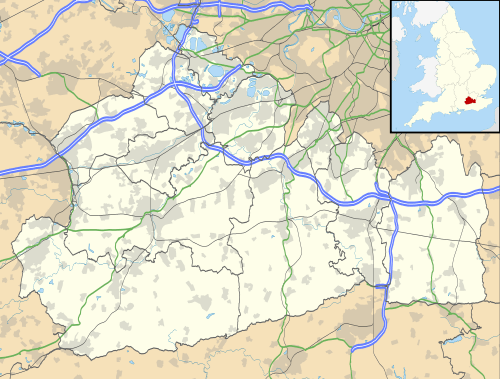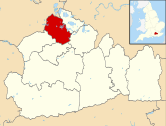Wentworth Estate
The Wentworth Estate is a 1920s-founded estate of houses and woodland across 7 square kilometres (2.7 sq mi) (a typical small village size in England) around the home of the first Ryder Cup, Wentworth Club. It is in Virginia Water, Surrey, England and forms one of Europe's premier residential areas on a gently undulating area of coniferous heath, a nationally rare soil type. Most of its invariably large plots have homes built from scratch or rebuilt after 1930 in a range of styles from the ornate multi-chimneyed Arts and Crafts movement of the earliest properties through Neo-Georgian and colonial revival to the postmodern simple style as in the recording studios at John Lennon's Tittenhurst Park (1971) in the adjoining parish of Sunninghill and Ascot, the north of which, with parts of Windsor, Winkfield and Virginia Water is the main piece of Crown Estate in South-East England, Windsor Great Park.
| Wentworth Estate | |
|---|---|
_by_George_Frederick_Prosser.jpg) View of Portnall Park, from the south-east, published in 1828. Once the home Colonel Bisse-Challoner, it is now known as the Dormy House. The cluster of sheep have been replaced by a Wentworth golf course fairway. | |
 Wentworth Estate Location within Surrey | |
| Population | less than 2,000 |
| OS grid reference | SU9867 |
| District | |
| Shire county | |
| Region | |
| Country | England |
| Sovereign state | United Kingdom |
| Post town | Virginia Water |
| Postcode district | GU25 |
| Dialling code | 01344 |
| Police | Surrey |
| Fire | Surrey |
| Ambulance | South East Coast |
| UK Parliament | |
History
19th Century
The 19th-century house the "Wentworths" (now the club house for the Wentworth Club) was the home of a brother-in-law of the 1st Duke of Wellington. It was purchased in 1850 by the exiled Spanish count Ramon Cabrera, and after his death his wife bought up the surrounding lands which were later to form the nucleus of the Wentworth Estate.[1]
20th Century
In 1912, builder W.G. Tarrant had started developing St George's Hill, Weybridge – a development of houses based on minimum 1-acre (0.40 ha) plots based around a golf course. In 1922 Tarrant acquired the development rights for the Wentworth Estate, getting Harry Colt to develop a golf course around the "Wentworth" house. Tarrant developed the large houses on the estate to a similar Surrey formula used at St George's Hill – tall chimneys, dormer windows, gables, leaded lights, tile-hung or half-timbered or a combination of both; most using hand-made bricks and tiles. Some houses had stonework round the front door and stone fireplaces, a few had a marble floor in the hall, and the rarest – of which he was most proud – had a stone tablet with his initials WGT.[2]
Development of Wentworth Estate ground to a halt due to depression in the late 1920s, and in 1931 when the banks asked for repayment of a large debenture, Tarrant was forced to declare bankruptcy. The ownership of the land passed to Wentworth Estates Ltd, which came under the control of Sir Lindsay Parkinson & Co Ltd. Construction picked up in the late 1930s, with many houses built by Tarrant Builders Ltd, with Tarrant's son Percy as one of the directors; but again stopped during World War II when the need arose to build high-density housing close to Virginia Water railway station.[3]
Wentworth Subterranean Bunkers
With the outbreak of World War II, Wentworth Estate was selected as an alternative seat of government and a rural command post, offering fewer security problems and more resources than the London Cabinet War Rooms (see also Cabinet War Rooms - Military Citadels under London.[4] A subterranean bunker and tunnel system, now sealed and covered by car parks, was built near the Clubhouse. Designed by Harley Dalrymple-Hay[5], it was constructed in 1939 and consisted of two 25 feet (7.6 m) diameter parallel tunnels made from cast iron London Underground tube segments with a 12 feet (3.7 m) diameter service tunnel running between them. The bunkers were oppcupued by the GHQ Home Forces, and later the 1st Signal Regiment. The bunkers were vacated in December 1944. [6][7](See also)
Post-war
Post-war development picked up considerably, and by 1960 most of the available land was already used.
Planning and amenities
In 1962, a committee of residents and the company promoted a private act of Parliament, and on 31 July 1964 the Wentworth Estate Act was given Royal assent.[8] The Act established the Wentworth Estate Roads Committee, which appoints its members on advice from the Wentworth Residents' Association.[9][10]
The Wentworth Estate is laid out across 700 hectares (1750 acres) and forms one of Europe's premier residential areas.[11] Within the estate borders are a mixture of public and private roads, footpaths and open areas. It adjoins along a long border the long row of its village's shops, restaurants and other amenities, which is laid out upon similar lines but has many 21st century converted mansion and newly built apartments.[12]
The River Bourne runs through the area which has a population of 5,895.[13]
Transport
- Road
Wentworth is just outside the ring of the London Orbital with a junction 3 miles (5 km) north. Routes from the west of the estate lead into Berkshire and towards Camberley and the Bagshot junction of the M3, which links to Southampton and to the A303.
- Rail
Wentworth is adjoined to its south and east by a major stop and minor stop railway station on the London Waterloo to Reading Line: Virginia Water and Longcross respectively.
- Air
Wentworth is 7 miles (11 km) south-west of Heathrow Airport; in private aviation Fairoaks Airport is 5 miles (8 km) south, accessible through Lyne and Ottershaw.
Residents
The estate hit the headlines in 1998 when former Chilean dictator Augusto Pinochet was kept under house arrest in one of its houses prior to his extradition.[14][15]
- Peter Aven – Russian banker[16] formerly Vijay Mallya's residence.
- Thomas Bjørn – golfer
- Sultan of Brunei[17]
- Ernie Els – South African golfer[18]
- Lady Wilnelia Forsyth-Johnson - former Puerto Rican Miss World and widow of Sir Bruce Forsyth
- Aidan Heavey - Irish businessman
- Gary Numan – musician
- Prince Naseem Hamed - former Boxing world champion
- Eddie Jordan - head of former Jordan F1 Team
- Ron Dennis - British businessman
- Kevin Pietersen - Retired England International Cricketer
Former residents
Founder residents included Agatha Christie and her first husband who was a friend of one of the estate's founders. The original residents built their own homes in any style they wished. She and her husband separated while living there and she sold the house, reportedly to pay the loan she had taken out to pay for it.
- Russ Abbot – entertainer [19]
- Boris Berezovsky – oligarch[20]
- Diana Dors – actress
- Bryan Forbes – actor and film director [21]
- Sir Bruce Forsyth – entertainer [22]
- Sir Elton John – musician [23]
- Nanette Newman - actress
- Augusto Pinochet, former President of Chile[24]
- Prajadhipok, abdicated king of Thailand[25]
- Sir Cliff Richard – singer
- Sarah, Duchess of York
- Andriy Shevchenko – striker for Chelsea F.C.[16]
- Ted Heath - bandleader
- John Hay Whitney - US ambassador to the UK, publisher, art collector, philanthropist and investor [26]
- Betsey Cushing Roosevelt Whitney
References
- Archives Network Wales – The de Morella Collection
- Books, Research and Information – Arts & Crafts Home
- BBC – WW2 People's War – It was totally different
- Wentworth Estate Website - History
- Catford, Nick (2013). Secret Underground London. ISBN 9780956440570.
- Subterranea Britannica
- 28 days later Urban Exploration - Wentworth
- "ROYAL ASSENT HC Deb 31 July 1964". Parliament of the United Kingdom. 31 July 1964. Retrieved 16 October 2019.
- Wentworth Estate – History
- "Welcome To The Wentworth Estate - The Wentworth Estate". The Wentworth Estate. Retrieved 13 September 2017.
- BBC NEWS | England | Surrey | Priciest street outside of London
- Wentworth Estate
- Census data
- BBC News | World | Pinochet retreats to luxury estate
- Pinochet, General Augusto, Archive news
- Safe as houses: the KGB-proof mansion Sunday Times – 6 May 2007
- unofficial-guides.com – Royal Holloway
- Time for something Els | Golf | Guardian Unlimited Sport
- "Knowing Russ". www.russabbot.co.uk. Retrieved 13 September 2017.
- Moscow on the Thames The Telegraph
- "Bryan Forbes". IMDb. Retrieved 13 September 2017.
- "A Life in the Day: Bruce Forsyth". The Sunday Times. 21 September 2008. ISSN 0956-1382. Retrieved 13 September 2017.
- "Elton At Home". Getty Images. Retrieved 13 September 2017.
- Pinochet retreats to luxury estate
- Compton House, Lake Road, Wentworth Estate, Surrey, accessed 3 March 2015
- Jane., Brown (1987). Lanning Roper and his gardens. London: Weidenfeld & Nicolson. ISBN 0297790293. OCLC 17436174.
External links
| Wikimedia Commons has media related to Wentworth Estate, Surrey. |
